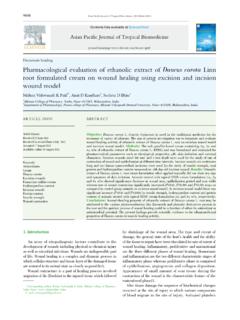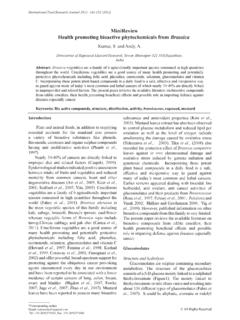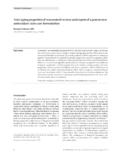Transcription of Review Article …
1 Hindawi Publishing CorporationEvidence-Based Complementary and Alternative MedicineVolume 2012, Article ID 696230,6 ArticleNigella sativa: A Potential Antiosteoporotic AgentAhmad Nazrun Shuid, Norazlina Mohamed,Isa Naina Mohamed, Faizah Othman, Farihah Suhaimi, Elvy Suhana Mohd Ramli,Norliza Muhammad, and Ima Nirwana SoelaimanDepartment of Pharmacology, Faculty of Medicine, National University of Malaysia (UKM), Kuala Lumpur Campus,Raja Muda Abdul Aziz Road, 50300 Kuala Lumpur, MalaysiaCorrespondence should be addressed to Ima Nirwana 2 April 2012; Revised 20 July 2012; Accepted 8 August 2012 Academic Editor: Srijit DasCopyright 2012 Ahmad Nazrun Shuid et al. This is an open access Article distributed under the Creative Commons AttributionLicense, which permits unrestricted use, distribution, and reproduction in any medium, provided the original work is sativaseeds (NS) has been used traditionally for various illnesses.
2 The most abundant and active component of NS isthymoquinone (TQ). Animal studies have shown that NS and TQ may be used for the treatment of diabetes-induced osteoporosisand for the promotion of fracture healing. The mechanism involved is unclear, but it was postulated that the antioxidative, andanti-inflammatory activities may play some roles in the treatment of osteoporosis as this bone disease has been linked to oxidativestress and inflammation. This paper highlights studies on the antiosteoporotic effects of NS and TQ, the mechanisms behind theseeffects and their safety profiles. NS and TQ were shown to inhibit inflammatory cytokines such as interleukin-1 and 6 and thetranscription factor, nuclear factor B. NS and TQ were found to be safe at the current dosage for supplementation in human withprecautions in children and pregnant women.
3 Both NS and TQ have shown potential as antiosteoporotic agent but more animaland clinical studies are required to further assess their antiosteoporotic sativaNigella sativais a herbal plant which belongs toRanuncu-laceaefamily. It is also known as black cumin orhabatussauda, and has a rich historical and religious is found in the southern region to 30 cm and produces pale of follicles which contain theseeds, the mostvaluable part of the plant. The seeds ofNigella sativa(NS),which have a pungent bitter taste, are used in confectioneryand liquors. The seed is the source of the active ingredientsof this plant and has been used in Islamic medicine for itshealing powers [1]. Studies have revealed various therapeuticvalues of NS such as anticancer, antioxidant, antibacterial,antifungal, antiparasitic and antiasthmatic [2 7].
4 NS mayalso inhibit renal calculi and improve poultry quality [8,9].NS contains 36 38% fixed oils, proteins, alkaloids, saponin,and essential oil [10]. High-performance liquidchromatography (HPLC) analysis of NS essential oil revealedthat the main active ingredients were thymoquinone, dithy-moquinone, thymohydroquinone, and thymol [11]. Amongthe compounds identified, thymoquinone (TQ) is the mostabundant, which makes up 30 48% of the total quinine constituent is the most potent and that NS and TQ have beneficial effects on bone andjoint OsteoporosisThe major bone disease is osteoporosis, a systemic skeletaldisease characterized by low bone mass and microarchitec-tural deterioration of bone tissue, with a consequent increasein bone fragility and susceptibility to fracture. According toWorld Health Organization (WHO), osteoporosis is definedas a bone mineral density that lays standard deviationsor more below the average value for young healthy osteoporosis, bone loss occurs especially at the trabecular2 Evidence-Based Complementary and Alternative Medicinearea when the balance of bone remodeling is tipped towardsbone resorption.
5 The bone loss is associated with bonebiochemical marker changes such as reduction in osteocalcinlevel, the marker for bone formation and elevation in cross-link C-telopeptide, the marker for bone resorption. Thediagnosis of osteoporosis is made using dual emission X-ray absorptiometry (DEXA) machine but more sophisticatedthree-dimensional micro-computed tomography (micro-CT) is making way for a better paper attempts to discuss the beneficial effects of NSand TQ, its active compound, on osteoporosis and Postmenopausal OsteoporosisThe main cause of osteoporosis is menopause or estrogen-deficiency. Several medicinal plants have been studied usingpostmenopausal osteoporosis animal model such as soy,blueberry,achyranthes bidentata,andlabisia pumila[12 15].To date, there is no study of NS or TQ on postmenopausalosteoporosis animal model.
6 There was a human study onthe effects of NS supplements on the bone markers ofpostmenopausal women [16]. It was found that NS supple-mentation for 3 months to these postmenopausal womenfailed to cause any significant changes in the bone markerslevels. The authors concluded that NS was not recommendedfor the treatment of postmenopausal osteoporosis. However,there were several weaknesses in the study which mayaccount for the nonsignificant results. The sample size ofonly 15 postmenopausal women was too small. The durationof study should be longer to obtain bone markers readings atseveral time points and to register any changes in the bonemineral density. Noncompliant in taking NS oil was also aproblem due to the nonfavorable greasy taste. In the future, along term study with larger sample size should be in the form of capsules should be given to the studyparticipants to improve compliance.
7 Before that, the effectsof NS should be tested in animal osteoporosis are also required to determine the effects of NSon osteoblasts and Diabetes-Induced OsteoporosisCurrently, NS has only been tested in animal osteoporosismodel of diabetes-induced osteoporosis. No study has beenconducted on other osteoporotic animal models. Osteoporo-sis is now accepted as a major complication of patientswith diabetes mellitus. Diabetes could affect bone throughmultiple mechanisms such as insulin deficiency, insulin resis-tance, hyperglycemia, or atherosclerosis. However, the exactmechanism responsible for osteopenia in diabetes is stillunknown [17]. Insulin and insulin-like growth factors (IGF-1) may have some roles to play in the pathogenesis ofdiabetic-induced bone loss due to their anabolic effects [18].
8 A study found that combined treatment of NS andparathyroid hormone was more effective in reversing theosteoporotic changes and improving the bone strength ofsteptozocin-induced diabetic rats than either treatment alone[19]. In another study using the same model, histologicalassessments found that NS was able to ameliorate diabeticchanges of the bone [20]. These findings suggested thatNS has potential to be used for the treatment of mechanisms behind the bone protective effects ofNS against diabetes induced-osteoporosis are still may have improved the bone metabolism by improvingthe blood sugar levels. In certain parts of the world, NSis frequently used as the traditional treatment of diabetes[21]. Studies on streptozotocin-induced diabetic rats haveshown that NS may reduce hyperglycaemia, increase seruminsulin concentrations, and promote partial regeneration orproliferation of pancreatic beta cells, causing an increase ininsulin secretion [22 25].
9 Inotherstudy,NStreatmentsofdiabetic rats have been shown to increase the area of insulinimmunoreactive beta-cells. These results have shown that NSmay be used as an effective antidiabetic therapy [19]. Thereis a possibility that NS may have exerted its antiosteoporoticeffects in diabetes by improving the blood sugar profile, butfurther studies are required to confirm that, previous literatures on NS and TQ havehighlighted two properties that may be responsible for theirantiosteoporotic effects, that is, antoxidative and antiinflam-matory The Antioxidant Role of NS andTQ against OsteoporosisOsteoporotic patients were found to be under oxidativestress as their lipid peroxidation levels were elevated andantioxidant enzymes reduced [26,27]. Most risk factorsfor osteoporosis were associated with oxidative stress suchas hypertension [28], diabetes mellitus [29], and smoking[30].
10 Exposure to oxidative stress would result in reductionof bone-mineral density [31]. In bone studies, ferric nitril-o-triacetate (FeNTA) was used to induce osteoporosis viaoxidative stress [32]. The ferric ions (Fe3+) in FeNTA gen-eratereactiveoxygenspeciesthroughFen tonreaction[33],which may damage bone cells by lipid peroxidation [34,35].They could also stimulate osteoclast formation and activity[32,34,36], impair osteoblastic function [34,36], anddecrease osteoblast recruitment and collagen synthesis [35].Free radicals have also been shown to activate nuclear factor-kappa B (NF B) and raised the levels of bone-resorbingcytokines, interleukin-1(IL-1), and interleukin-6 (IL-6) [32,37].Since it is apparent that oxidative stress may lead toosteoporosis, antioxidants may play a role in protecting boneagainst the damaging effects of free-radicals.





